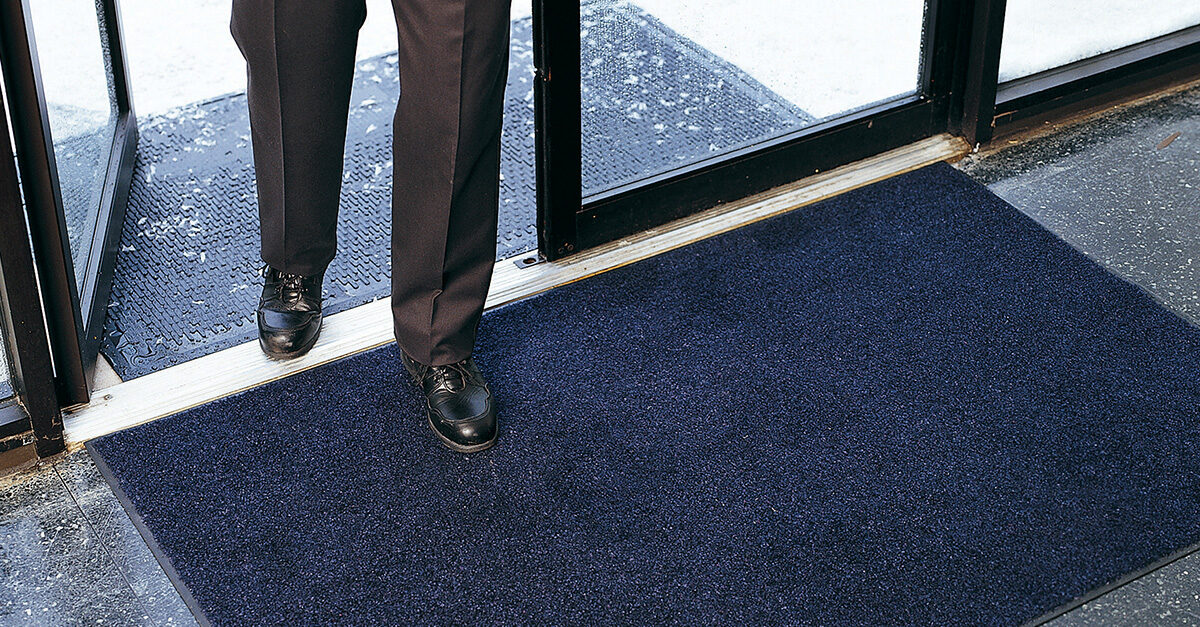Floors experience the most wear and tear within a building and are the first asset visitors notice when they walk in. Day-to-day foot traffic can wreak havoc on facility floors, especially during winter months when snow, ice, salt, and sand are factored in. The debris creates scratches and worn areas on the floor, which can negatively affect a business’s image.
Businesses have different types of floors, which are all uniquely affected by debris from inclement weather. For example, scratches and worn areas on floors with finishes, stains, or sealants can cause facilities to perform costly and time-consuming refinishing processes that diminish the life of the floors, especially if the floors have not been maintained regularly. This can result in expensive floor replacements earlier than expected.
Practice winter floor care
It’s critical to implement preventative measures such as a comprehensive matting program as 85% of dirt won’t enter a building if mats are properly placed and maintained, according to ISSA. It’s also important to implement reactive measures to account for any dirt and debris that’s not picked up by mats. This should include a floor cleaning program that incorporates periodic deep cleans to keep floors in top shape during the winter.
Implement matting programs
A comprehensive matting program is a highly effective preventative measure. Without adequate matting, 42% of a floor’s finish can be removed within the first six feet of an entrance after only 1,500 people have walked in, according to 3M. Choose scraper mats that feature active blades of various heights to scrape grime and debris off shoes outside front entryways. This feature helps prevent snow, ice, salt, and other debris from entering the building and creating unwanted puddles and messes. Consider a mat with drainage holes that drains moisture outside, avoids soil accumulation on the mat, and reduces the amount of dirt tracked into facilities.
Facilities can install additional carpet mats to pick up excess debris. Invest in mats with advanced, fast-drying microfibers that create more surface area to capture and hold contaminants. This will help remove fine particles stuck in shoes and provide quicker evaporation of moisture. For high-traffic areas, use matting that features heavier rubber backing to decrease movement and enhance grip.
While high-performance mats can help facilities combat “winter floor syndrome,” each mat must be cared for, with special attention paid to mats near front entryways. As facilities experience high foot-traffic and inclement weather, mats can become oversaturated if maintenance isn’t consistent. Oversaturation produces an inkpad effect, which causes the mat to overflow and visitors to track more dirt and debris throughout facilities.
Proper mat maintenance is therefore critical. Ensure mats are installed and maintained correctly by partnering with a qualified service professional that offers freshly cleaned replacement mats while cleaning the dirty ones. Alternatively, if facility managers decide to purchase mats, make sure to clean and maintain the mats regularly. This includes ongoing vacuuming to reduce any dust or dirt that might be on the surface, washing and drying mats, taking the mat outside to shake off excess dirt and dust, and having an extra rotation of mats to use when the others are cleaned.
Follow floor maintenance programs
While a matting program is an effective way to keep debris from entering a facility, regular floor maintenance is also important. The following best practices can help maintenance personnel clean and protect floors:
- Increasing mopping frequency: A staff member should regularly mop entryways and other floor surfaces throughout the facility. This can remove salt lines from ice melt and reduce water accumulation from heavy snow and freezing rain. Use heavy-duty wet mops and microfiber mops that capture and remove moisture from floors. For spot cleaning or picking up small spills, consider a pulse mop that doesn’t require prepping a mop bucket.
- Cleaning tools: As floors become dirtier, cleaning tools will too. Staff members should regularly change out mop water and use dual-chamber mop buckets to reduce the cross-contamination of dirty water and cleaning chemicals.
- Cleaning out the chemical closet: The type of cleaning chemicals used can impact the floor care program’s efficacy. Use cleaning chemicals that will remove salt residue effectively while also cleaning the floor surface.
- Maintaining periodic deep cleaning: Keeping up with regular deep cleans, especially during the winter months, can minimize the burden of daily cleaning and extend the life of floors. Deep cleaning can also restore facility floors to “like new” condition, resulting in a favorable customer outlook.
Keep facilities stocked and employees trained
Stopping harmful winter weather debris from entering a facility is key to maintaining clean floors. To do so, keep all maintenance items in an adequate supply in addition to implementing a proper mat program.
Staff members should receive proper training and understand the correct floor cleaning procedures. As a facility manager, it’s necessary to educate staff on the importance of winter floor cleaning to keep a facility’s image favorable to customers.
Be proactive
Facility managers should be proactive in preparing facilities for unavoidable winter weather as floor care during the winter requires more time and attention than any other season. Installing and maintaining mats and keeping up with preventative and reactive measures will help keep salt, snow, and other winter debris from entering a facility—and reduce floor care costs.




